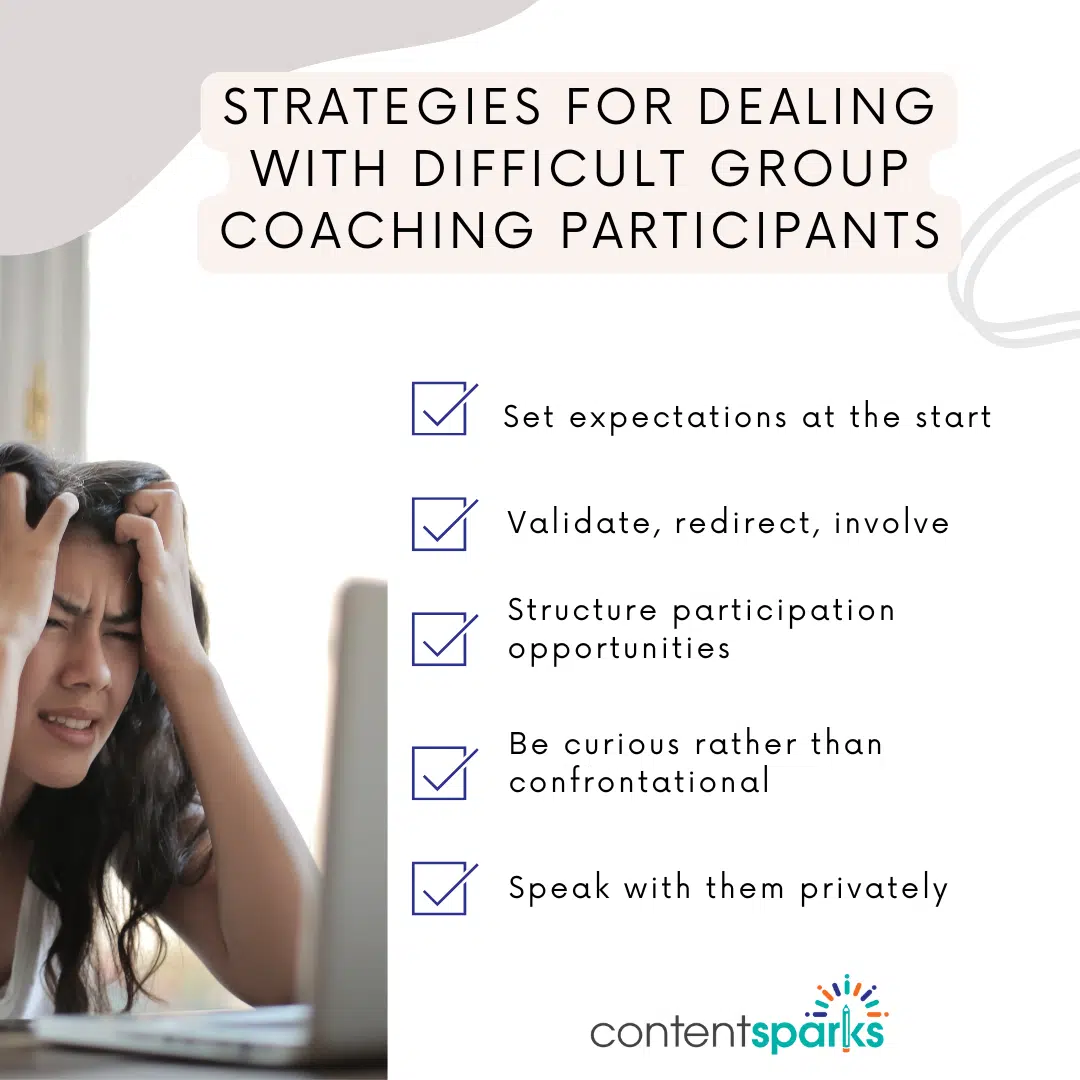How to Deal With Difficult Group Coaching Participants
0 comments
0 comments
You’ve put in hours of work to build a list and write a launch sequence, and it finally paid off with a Zoom screen full of willing participants in your latest group coaching program.
You made it right?
Before the dollar signs can settle in your eyes, someone raises their hand (or more likely, just blurts out what they’re thinking – hello, Zoom etiquette?).
You break out into a sweat... Who is asking the question? Will it be Mr. Chatterbox who talked nonstop through the icebreaker session? Is it Mr Clueless, who has no idea why he's here, he's an expert. Or will it be someone else?
The last thing you want is to deal with difficult training participants, but the reality is that you probably will at some point. Read on as I break down the four types of difficult participants you will encounter and share strategies for dealing with them (and keeping the peace).
Group coaching can be a fantastic way to scale your coaching or services business… but one con of coaching a group of people is just that, you need to work with a group of people rather than work with clients one-on-one.
Individually, difficult people can be somewhat easy to manage. But as a group? One difficult participant can derail the entire program and cause other participants to feel they aren’t getting value.
The four most common types of difficult participants I have encountered are:
Let me introduce you to them.
You’ll know this one right away.
“Mr. Chatterbox” means well, but he loves the spotlight almost as much as he loves the sound of his own voice. At some point, you may think he joins training sessions just to hear himself talk!

With wise handling, though, Mr. Chatterbox will be your ally. By giving him a moment in the spotlight and then limiting future interactions, you can rein him in while allowing him to contribute and add value to the group. Again, he means well but will often require a reminder to include the rest of the room and leave space for others to speak.
On the other side of the spectrum, we have “Ms. Quiet.”
Ms. Quiet rarely speaks outside of a polite “hello” at the beginning, but could be silent during your sessions for a number of reasons:

Whatever it is, I recommend taking them aside and discovering why they're quiet to better understand how you can empower them to contribute. Moving them into a small group so they don't feel overwhelmed will gently encourage participation.

Group Coaching Program Outline and Planner
Request your free copy of the Group Coaching Program Outline and Planner to help you.
Like “Mr. Chatterbox,” it doesn’t take much time to recognize “Mrs. Challenging.”
She's been there, done that, written the book, gotten the t-shirt, and now drop-ships her own mugs with motivation quotes on the topic of your training. She's challenging for sure!

Out of all the difficult training participants, Mrs. Challenging is the toughest to deal with because she often feels the need to interject no matter what you say – even if she agrees with you!
The secret to winning her over is to not argue with her and to pair her up with Mr. Chatterbox whenever you can. I’ll share some more tactics you can try to bring sessions back on track when she gets started.
Ah… “Mr. Clueless.”
He has no idea why he's here. He says so at every opportunity. His superpower is leading discussions off-topic. There will be moments you think he's doing this on purpose, but the truth is he just needs more direction and guidance than your average group coaching participant.

Rather than let him derail a session for the upteenth time, guide him gently back onto the track, and make sure he has all the handouts so he can catch up on what he's missed.

Between those four, you may be put off from offering a group coaching program altogether.
Don’t. In addition to the above tactics, there are ways to rein in even the most difficult training participants. You just need a caveman’s sense of psychology and a few helpful framing techniques:

Group Coaching Program Outline and Planner
Request your free copy of the Group Coaching Program Outline and Planner to help you.
Set Clear Expectations Upfront
While it won’t prevent the most daring of difficult participants, setting clear expectations can help ensure most act on their best behavior.
Try setting up group agreements or even an official “code of conduct” at the beginning of your program. It’s helpful to clearly communicate boundaries around participation, respect, and communication styles. That way, when participants act out, you have something backing you up if you need to ask them to behave better or drop them from the program.
A subtle trick you can try if someone (especially Mrs. Challenging) interrupts in an unhelpful way is to validate their contributions, redirect them to your material, and involve others.
This is a nonconfrontational way to stop an argument in its tracks, and prevents rebuttal as others will have a window to chime in and change the tone of the conversation.
For example, let’s say you’re presenting a methodology for SEO, and Mrs. Challenging begins disagreeing at each point you make. Rather than argue, you can say something like, “Well, yes, I can see how your method worked in that instance. It’s actually not too dissimilar from the way I approach things. Has anyone else in the group experienced the same?”
For those who talk a lot (looking at you, Mr. Chatterbox), structuring participants can help prevent sessions from going off the rails.
Techniques like:
And more can help limit each person’s impact and ensure everyone has an equal opportunity to contribute. This naturally limits individuals who might otherwise dominate the conversation.
I find that in the face of adversity, it helps to stay curious rather than get confrontational.
When Mrs. Challenging interrupts you or begins to disagree, it’s easy to jump into an argument. Instead, coming in from a place of curiosity can help disarm even the most combative participants and steer the conversation toward a more productive direction.
Questions like:
These can de-escalate tension and steer the conversation back to a more productive place for other participants.
If all else fails, then it’s time to take things to a one-on-one conversation rather than try to diffuse in a group setting.
I recommend using this as a last resort for the most difficult and disruptive participants. Calmly explain your observations about their behavior without judgment while referring to the code of conduct for the group. Then pause and listen to their perspective. This allows you to avoid an argument and involve them in trying to improve the situation.
If they refuse to improve or continue to be combative, it may be worth removing them from the group altogether.
Group coaching programs can be a fantastic way to scale your business and free up time, but that doesn’t mean it’s easy. While serving more clients in less time can be great, sometimes a few of those clients can be disruptive.
I hope that this guide helps you the next time you recognize one of the four profiles I shared. There’s more to selling a successful group coaching program than disarming disruptive participants; for the rest, you’re going to want this free worksheet by your side.
Click the button below to download my free worksheet to design a group coaching program that “wows” clients and earns you referrals and repeat customers.
Enjoy!

Tags